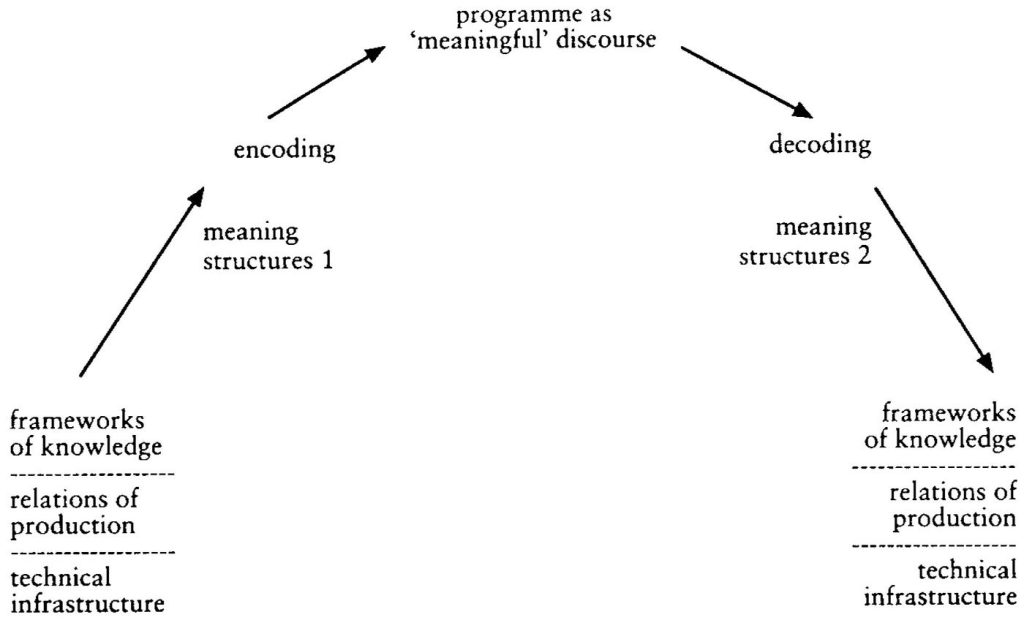Stuart Hall, one of Britain’s leading researchers in the field of literature, put forward the theory of “encoding and decoding” in a paper entitled “Encoding and Decoding in Television Discourse”.

Encoding and decoding are two steps in the process of disseminating information using symbols. Encoding is the communicator’s action of converting the message or meaning he or she desires to express into symbols such as language, text, sound, and visuals. Decoding, often known as decoding, is the process of deciphering and comprehending incoming signals and communicating their meaning to the intended audience. Connecting encoding and decoding is simply a simple communication procedure. Some literary scholars think that the encoding and decoding procedures represent the shield and struggle between the dominant file and the subordinate subfiles.
Hall mode
The listener may interpret the communication’s content differently depending on their level of social standing, knowledge base, and the relationship between the communicator and the decoding context. Hall posits that the primary determinant of audience decoding is the audience’s social class standing. Additionally, he suggests three decoding positions based on audience class:
(1) Dominant-hegemonic position: the audience identifies with the dominant ideology and reads within the coder’s framework. An alternative name for it is “dominant-hegemonic” interpretation.
Elites from the middle and upper echelons of society make up the audience members who take up this role. Because the text’s ideas align with their own interests, they wholeheartedly embrace its ideology.
(2) Negotiated stance: Consisting of a blend of antagonistic and compatible parts, the audience maintains a dominant ideology while agreeing with it in accordance with their group’s viewpoint. This leads to a condition of conflict and negotiation with the prevailing ideology. Interpretation that is “negotiated” is another term for this.
The middle class of society is the target audience for this stance. They negotiate a mutually acceptable interpretation, accepting in principle the dominant ideology’s interpretation, but not entirely agreeing with it. The middle class’s goals and desires do not entirely align with those of the ruling class, as represented by the communicator, which is the cause of this incomplete agreement.
(3) Oppositional position: Upon understanding the code, the audience takes a stance that is wholly at odds with the dominant code, interpreting the new interpretation in light of their personal experiences. The term “confrontational” interpretation is also used.
These three ways of decoding are also known as the “Hall model”. This model suggests that meaning is not “transmitted” by the transmitter, but “produced” by the receiver.

Three Stages of Television Discourse Circulation
Traditional mass communication research, according to Hall, conceptualises information dissemination as a unidirectional linear model of “senderŌåÆmessageŌåÆreceiver,” which only focuses on the level of information exchange and fails to view dissemination as a complex relational structure. He saw communication as a “dominant complex structure” with four stages: “production, circulation, distribution, and consumption, and reproduction.” He proposed a three-stage theory of television discourse circulation.

Step 1: Television personnel process, or encode, the raw content to create “meaning” in television conversation.
Step 2: The “finished product” stage occurs after the producer has infused the TV text with “meaning,” at which point the language and discourse norms of the program’s meaning take centre stage and the TV show transforms into an open, polysemous discourse system.
The third stage is crucial since it’s when the audience starts to truly circulate meaningŌĆöthe “decoding” stage.
Step 4: The phase of reproduction. At this point, the audience creates original texts and fresh meaning interpretations.
Conclusion
Hall examines how symbolization functions in the process of cultural communication, giving the symbol code a rich directionality of meaning and imbuing it with meaning. These interpretations also adhere to the norms of how they are broadcast to the general public, as in television and films. Hall contends that there are two sides to the control and counter-control of cultural hegemony, reinterpreting it in the context of the media discourse system. Based on his or her position, the decoder as receiver has every opportunity to counter the hegemonic elements of the dominant runes. Finally, Hall emphasises that while the audience’s reaction to the message is what truly makes communication far-reaching, encoders and decoders are bound to have biassed perceptions of the message due to other factors like cultural perceptions and ideologies.
Reference
https://medium.com/brixenlabs/stuart-hall-7f75ce66a847
http://henryjenkins.org/blog/2020/6/2/stuart-hall-island-boy-by-keesha-wallace

I learnt a lot from this article as the author successfully navigated the complexities of Hall’s model, deconstructing the encoding and decoding processes and linking them to the dynamics of communication in television discourse. In particular, the three decoding stances included in the article “the hegemonic dominant stance, the bargaining stance, and the oppositional stance”, enable readers to grasp the subtle ways in which audiences interpret media messages according to their social class status. The value of this thesis is further enhanced by exploring the three stages of television discourse circulation. By delving into the stages of production, circulation, dissemination, consumption and reproduction, readers can more easily understand how television discourse produces and interprets meaning. However, the essay would have been more informative if it had explored more explicitly how the dynamics of encoding and decoding varies between different media forms, such as print, broadcast and digital platforms. In addition, the impact of the article would have been greater if it had illustrated the relevance and applicability of Hall’s theory in today’s media environment by presenting contemporary examples and case studies.
The blog post offers a thorough and insightful exploration of Stuart Hall’s theory of encoding and decoding, presenting it in a manner that’s both informative and engaging. It skillfully breaks down complex ideas into understandable segments, making the nuances of media communication accessible to a broader audience. The emphasis on the different ways audiences interpret messages based on their social standing and the outlined stages of television discourse circulation are particularly enlightening. This post not only serves as an educational resource but also encourages readers to reflect on their own media consumption and the broader implications of communication in society. Overall, it’s a thought-provoking piece that sheds light on the intricate dance between media creators and consumers.